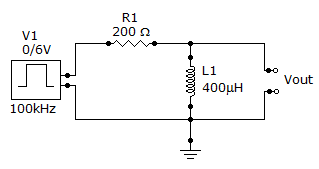Time Response of Reactive Circuits problems
- 1. An integrator consists of a 3.3 kΩ resistor and a 2 µF capacitor. A single 30 V, 6 ms pulse is applied to the input. How much will the capacitor charge?
Options- A. 10.3 V
- B. 30 V
- C. 12.09 V
- D. 17.91 V Discuss
Correct Answer: 17.91 V
- 2. A single 6 V pulse with a width of 600 µs is applied to an integrator consisting of a 150 kΩ resistor and a 0.002 µF capacitor. To what voltage will the capacitor charge?
Options- A. 0 V
- B. 3.78 V
- C. 5.16 V
- D. 6 V Discuss
Correct Answer: 5.16 V
- 3. The output of an RC integrator is taken across the
Options- A. diode
- B. capacitor
- C. resistor
- D. source Discuss
Correct Answer: capacitor
- 4. Referring to the give circuit, the output will

Options- A. decay to zero at the end of the pulse
- B. reach 6 V at the end of the pulse
- C. reach 3.78 V at the end of the pulse
- D. reach 5.16 V at the end of the pulse Discuss
Correct Answer: decay to zero at the end of the pulse
- 5. An RC differentiator acts as a
Options- A. low-pass filter
- B. high-pass filter
- C. band-pass filter
- D. band-stop filter Discuss
Correct Answer: high-pass filter
- 6. The flat portions of a pulse waveform contain low-frequency components.
Options- A. True
- B. False Discuss
Correct Answer: True
- 7. In an RL integrating circuit, the output voltage is taken across the inductor.
Options- A. True
- B. False Discuss
Correct Answer: False
- 8. If the capacitor in an integrator opens, the output has the same voltage as the input.
Options- A. True
- B. False Discuss
Correct Answer: True
- 9. In an RC differentiating circuit, the output voltage is taken across the resistor.
Options- A. True
- B. False Discuss
Correct Answer: True
- 10. A dc component is the peak value of a pulse waveform.
Options- A. True
- B. False Discuss
Correct Answer: False
More in Electrical Engineering:
Programming
Copyright ©CuriousTab. All rights reserved.
